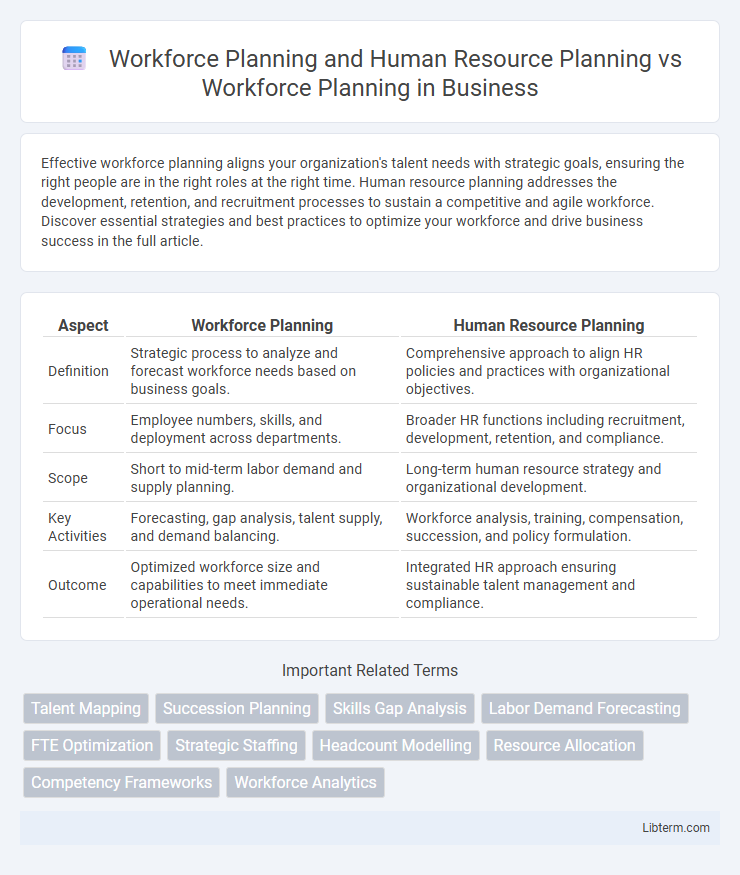Effective workforce planning aligns your organization's talent needs with strategic goals, ensuring the right people are in the right roles at the right time. Human resource planning addresses the development, retention, and recruitment processes to sustain a competitive and agile workforce. Discover essential strategies and best practices to optimize your workforce and drive business success in the full article.
Table of Comparison
| Aspect | Workforce Planning | Human Resource Planning |
|---|---|---|
| Definition | Strategic process to analyze and forecast workforce needs based on business goals. | Comprehensive approach to align HR policies and practices with organizational objectives. |
| Focus | Employee numbers, skills, and deployment across departments. | Broader HR functions including recruitment, development, retention, and compliance. |
| Scope | Short to mid-term labor demand and supply planning. | Long-term human resource strategy and organizational development. |
| Key Activities | Forecasting, gap analysis, talent supply, and demand balancing. | Workforce analysis, training, compensation, succession, and policy formulation. |
| Outcome | Optimized workforce size and capabilities to meet immediate operational needs. | Integrated HR approach ensuring sustainable talent management and compliance. |
Introduction to Workforce Planning
Workforce planning involves analyzing current workforce capabilities and forecasting future human resource needs to ensure organizational goals are met efficiently. Human Resource Planning encompasses broader strategic processes, including talent acquisition, development, and retention, while workforce planning specifically focuses on aligning labor supply with demand. Effective workforce planning uses data-driven projections and skill gap analyses to optimize employee allocation and productivity.
Defining Human Resource Planning
Human Resource Planning (HRP) involves systematically analyzing and forecasting an organization's future human capital needs to align workforce capabilities with strategic goals. Unlike Workforce Planning, which primarily focuses on immediate staffing requirements and operational deployment, HRP encompasses broader dimensions such as talent development, succession planning, and labor market trends. Defining Human Resource Planning centers on its role in optimizing employee performance by anticipating skill gaps and implementing long-term recruitment, retention, and development strategies.
Workforce Planning vs Human Resource Planning: Key Differences
Workforce Planning focuses on forecasting and aligning the quantity and skills of employees needed to meet future business demands, while Human Resource Planning encompasses a broader scope including talent management, employee development, and organizational culture. Workforce Planning is more data-driven and strategic, emphasizing demand forecasting and supply analysis to optimize labor costs and productivity. Human Resource Planning integrates workforce planning but adds elements like recruitment strategies, training programs, and compliance with labor laws to ensure long-term organizational effectiveness.
Objectives of Workforce Planning
Workforce Planning focuses on aligning an organization's labor supply with its demand by forecasting future workforce needs and identifying skill gaps to ensure optimal staffing levels. Its primary objectives include enhancing organizational agility, reducing labor costs, and improving productivity through strategic talent acquisition and retention. Human Resource Planning, while encompassing these elements, extends to broader HR functions like employee development and succession planning but lacks the specific, data-driven emphasis on strategic workforce alignment central to Workforce Planning.
Strategic Importance of Human Resource Planning
Human Resource Planning (HRP) is strategically important because it aligns workforce capabilities with long-term organizational goals, ensuring the right talent is available to meet future demands. Unlike general Workforce Planning which focuses on immediate staffing needs, HRP encompasses forecasting, talent development, and succession planning to support sustainable growth and competitive advantage. Effective Human Resource Planning drives proactive decision-making that optimizes employee performance and reduces skill gaps in dynamic business environments.
Steps in Effective Workforce Planning
Effective workforce planning involves analyzing current labor resources, forecasting future workforce needs, and developing strategies to address gaps through recruitment, training, or restructuring. Human resource planning, while closely related, emphasizes aligning workforce capabilities with organizational goals, focusing on talent management, succession planning, and employee development. Steps in workforce planning include demand analysis, supply analysis, gap analysis, solution implementation, and continuous monitoring to ensure optimal staffing levels and skill sets.
Integrating Technology in Workforce and HR Planning
Integrating technology in workforce planning and human resource planning enhances data accuracy and predictive analytics for optimizing talent acquisition and retention strategies. Advanced software platforms enable real-time workforce analytics, automated scheduling, and skills gap analysis, improving decision-making efficiency. Utilizing AI-driven tools aligns workforce capabilities with organizational goals, ensuring agile adaptation to market demands and workforce fluctuations.
Challenges in Workforce and HR Planning
Workforce planning faces challenges such as accurately forecasting labor demand, managing skill gaps, and adapting to technological changes, while human resource planning struggles with aligning talent acquisition to strategic goals and integrating diversity initiatives. Both processes encounter difficulties in retaining top talent amid competitive markets and addressing regulatory compliance in evolving labor laws. Effective collaboration between workforce and HR planning is essential to overcome constraints in data accuracy, budget limitations, and changing demographic trends.
Benefits of Aligning Workforce and HR Strategies
Aligning workforce planning with human resource planning enhances organizational agility by ensuring talent acquisition, development, and retention strategies directly support business goals. This integration optimizes resource allocation, reduces skills gaps, and improves employee productivity, leading to higher operational efficiency. Synchronizing these strategies also fosters proactive workforce management, enabling better response to market changes and future workforce demands.
Future Trends in Workforce and Human Resource Planning
Workforce planning and human resource planning both aim to align talent management with organizational goals, but workforce planning emphasizes forecasting labor needs based on future business scenarios, while human resource planning addresses broader HR strategies including recruitment, development, and retention. Future trends in workforce planning highlight advanced analytics, AI-driven predictive modeling, and scenario planning to manage skills gaps and workforce agility in rapidly changing markets. In human resource planning, emerging trends focus on integrating diversity, equity, inclusion initiatives, continuous learning platforms, and employee well-being programs to enhance workforce resilience and adaptability.
Workforce Planning and Human Resource Planning Infographic

 libterm.com
libterm.com